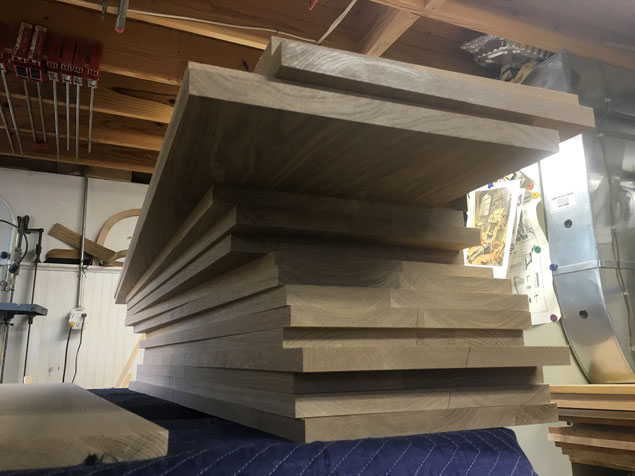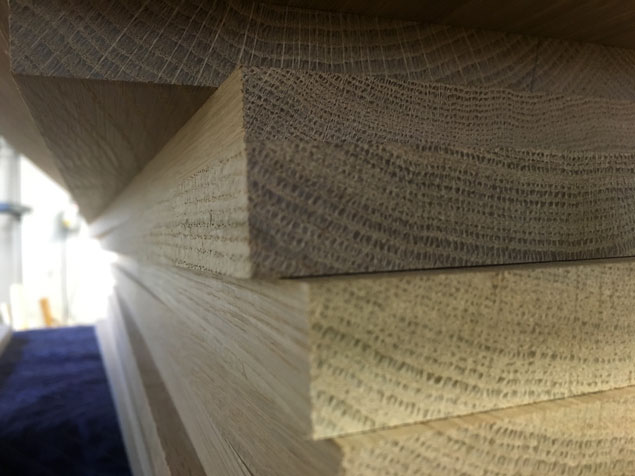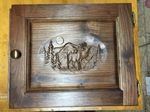We may receive a commission when you use our affiliate links. However, this does not impact our recommendations.
While I prefer to work with air-dried lumber, that’s not always possible for woodworkers who use a lot of wood or don’t have access to a dealer who air-dries stock.
One of the major problems with kiln-dried lumber is that it is sometimes rushed through the kiln to get it to market. As a result, the stock can become case-hardened (among other defects). You can’t tell a piece of lumber is case-hardened by looking at it. But you will be able to tell when you cut it.
It will pinch, sometimes violently, on the blade of your saw. The pinch can bend a handsaw or stop dead a 3hp cabinet saw. Even if you manage to rip it, the stock is likely to move constantly throughout the project every time you work with it.
As woodworker Rob Young notes: The best tool for that piece of wood is the fireplace.
This week I’ve been processing a lot of white oak for a 20’ run of shelves and have been amazed at how well behaved the wood is. No stresses. No warping. No case hardening.
It’s not luck. It’s because the wood is from a mill that is fanatical about its kiln schedules and knows how to dry white oak better than any other source I’ve encountered. The mill, by the way, is Frank Miller Lumber in Union City, Ind. I’ve been using that company’s oak for 20 years, and it has always been primo. And it’s remarkably inexpensive because I buy it right from the source.
I have found that it pays to form a relationship with a mill. Take a tour (if they’ll let you) to find out how the wood is processed. If you read up on typical kiln schedules (it’s different for hardwoods and softwoods), you can find out how much care they take in drying.
If you aren’t that hands-on, try this: Buy wood directly from the mill. If it stinks, never go there again. If it’s mild and behaves, give them as much business as you can.
This is a lot more trouble than going to a hardwood dealer – I have to drive four hours round trip to visit Frank Miller. But I throw away a lot less wood. It actually saves me money and frustration.
— Christopher Schwarz
Here are some supplies and tools we find essential in our everyday work around the shop. We may receive a commission from sales referred by our links; however, we have carefully selected these products for their usefulness and quality.












Sorry Chris but I can’t feel bad about your four hour round trip to get quality oak. My nearest box store is a four hour trip one way and there is no guarantee there will be any hardwoods of any description when I get there. The next closest that I know will have some kind of hardwoods is 11 hours one way. I make due with what I can get.
Furniture grade wood is kiln dried for about 30 days under controlled humidity and temperature. It is regularly sampled. Construction grade lumber is cooked for about 8 hours. Quite a difference!
Thanks Chris. Something else to think about.
I googled hardwood lumber in So. California, but could find no clues that might help me decide on a source that sells retail. I frequent Austin Hardwoods for my projects, with mostly good results, but I have had a few woodworking “events” that are suspect for case hardening in retrospect.
Anyone have hardwood source suggestions?
I remember that happening to me several years ago with my hand saw. Every time I tried to cut a piece it would pinch on my saw blade and sometimes locking it in the wood. Was a really big pain in the you know what. Never knew what the problem was until now. Thanks a lot for the information.
Hi
Probably a di.b question but is there any way to tell with a moisture meter or so.etching else?
Thanks
Joe
Very timely post for me. I’m currently building two bookcases from mostly rift sawn white oak, and it seems like it moves every time I turn around. It was purchased from a small local mill but no idea about their drying practices. The wood will even chip when hand planing with the grain. Very frustrating to work with.
Thanks, Chris. This may account for my experience with pine from the home center (maybe not a good choice!) of my handsaw pinching on crosscuts. I need to back out and saw another kerf next to the first to relieve the pinching. And, yes, I’ve had to flatten boards twice, even though the wood has been in my shop for months.